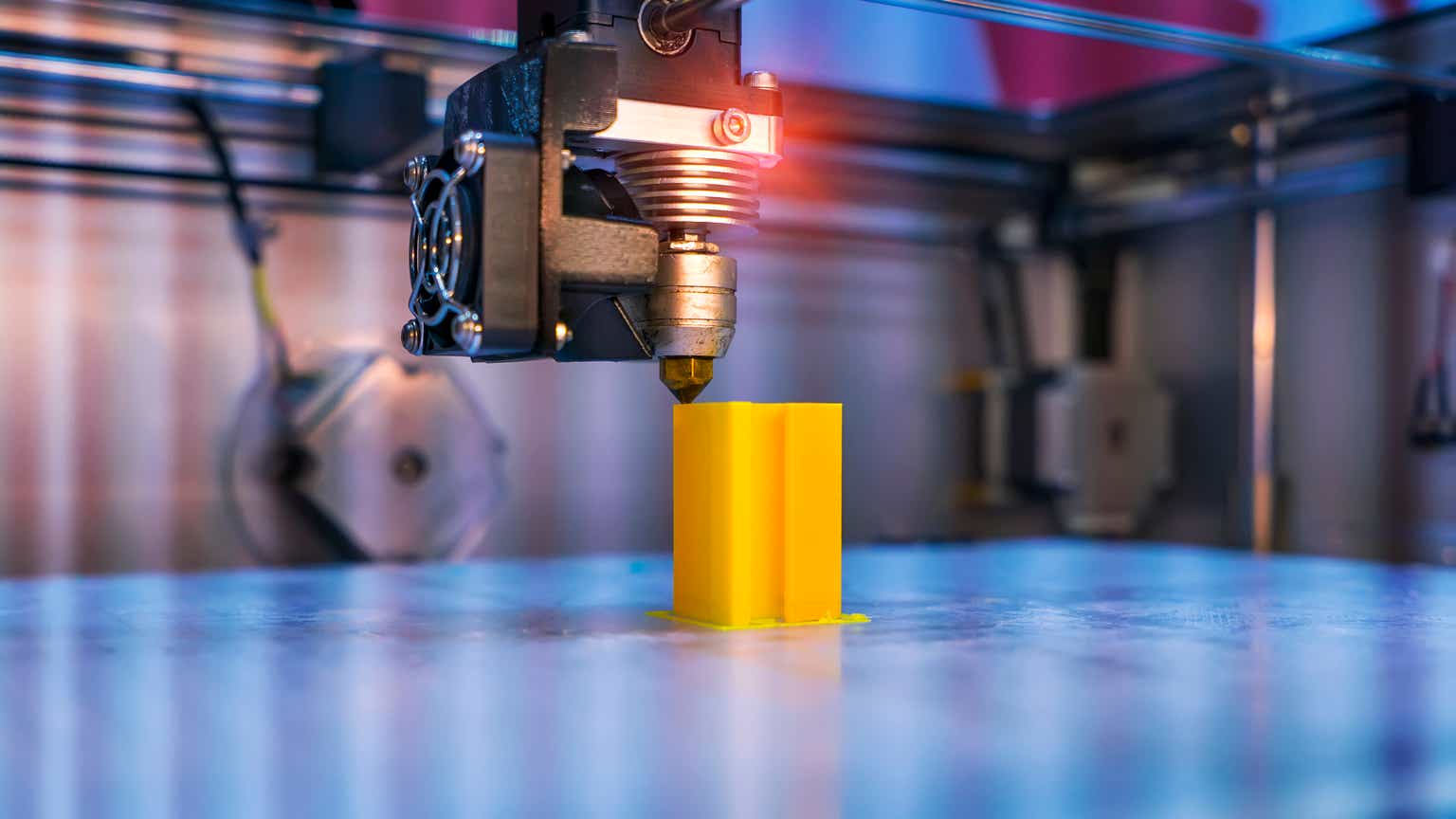Investment Thesis
Stratasys (NASDAQ:SSYS) is a polymer-based 3D printing manufacturer, offering solutions across various industries. They provide innovative 3D printing platforms, materials, and software to enhance product development, reduce costs, and streamline manufacturing processes.
Currently, Stratasys is conducting a review of its business to explore avenues for unlocking shareholder value. The bullish case here is that Stratasys discovers a meaningful application for its $350 million in net cash. This sum represents over 40% of its market capitalization, and the stock is trading at just its cash value. That’s the bullish scenario.
However, apart from that, I find very few reasons to recommend this stock to readers.
Stratasys’s Near-Term Prospects
Stratasys is a leader in polymer-based 3D printing solutions, offering a comprehensive array of technologies and complete solutions for various industries, including industrial, healthcare, and consumer sectors. Their primary focus is on polymer 3D printing solutions, addressing the rapidly growing manufacturing demands within the 3D printing industry.
Stratasys leverages its competitive advantages, including a wide range of 3D printing platforms, software, materials, and technology partnerships, to deliver innovative solutions that enhance product quality, reduce development time, and lower costs.
For instance, Stratasys serves industries such as aerospace, automotive, and healthcare and has made several strategic acquisitions to expand its photopolymer and resin-based 3D printing capabilities.
Recently, after the termination of its bid for Desktop Metal (DM), Stratasys has gone back to the drawing board to explore better ways to unlock shareholder value, given its lackluster progress and its share price once again at a multi-year low.
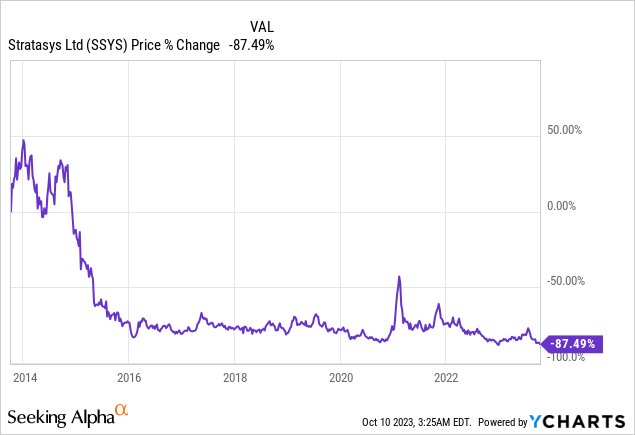
Challenges Faced by Stratasys
Stratasys has recently encountered several challenges. The combination of ongoing macroeconomic conditions, characterized by slower growth and higher interest rates, has affected customer spending cycles, resulting in longer sales cycles and a more cautious approach to capital investments.
To illustrate this, here’s a quote from the earnings call that reinforces this point:
So, we definitely see longer sales cycles, but we don’t anticipate a significant surge in orders going forward. It’s also related to our geographical diversification across different customers and the economic improvements in the U.S. The U.S. economy is still contracting, albeit less severely than in the past few quarters.
However, Stratasys maintains that its diversified portfolio will enable it to achieve its long-term goal of reaching $1 billion in organic revenue by 2026, without relying heavily on M&A activity.
Stratasys’s Revenue Growth Rates
SSYS revenue growth rates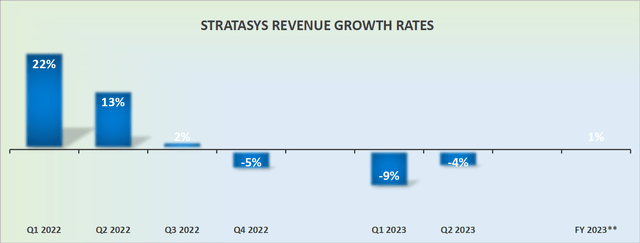
Stratasys has a track record of exhibiting fluctuating growth rates, with organic growth rates failing to inspire enthusiasm, despite its consistent M&A activities.
What’s particularly frustrating for Stratasys shareholders is the significant promise of 3D printing, especially in the transformative journey of the manufacturing industry. Despite enduring macroeconomic challenges, 3D printing technology offers opportunities to enhance flexibility and profitability across global manufacturing operations. With its diverse range of offerings, Stratasys should be ideally positioned to capitalize on the expanding addressable market and innovative solutions in sectors such as dental, materials, and healthcare.
While the industry faces challenges, the widespread adoption of 3D printing across multiple sectors should result in a stronger market presence for Stratasys and substantial growth. However, it remains a perpetual ‘jam tomorrow’ scenario, a narrative that has persisted in the minds of investors for years regarding Stratasys.
Profitability Profile
Here, I will highlight two different graphs. The first graph depicts a consistent upward trend.
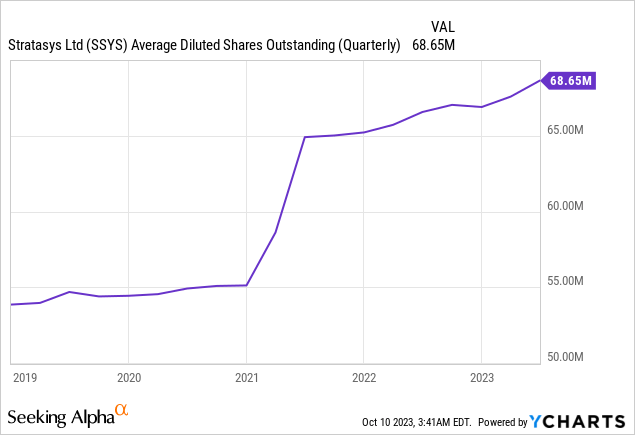
This graph represents Stratasys’ total shares outstanding over the past 5 years. Now, let’s contrast that with Stratasys’ GAAP operating income for the same period.
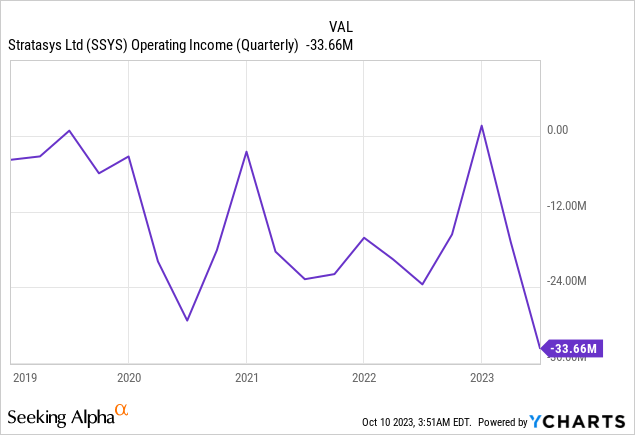
What we observe is a disparity. Despite the increasing number of shares over time, we do not see a corresponding rise in underlying profitability.
Given this context, do investors believe that paying more than 40x this year’s non-GAAP EPS makes sense for this business?
The Bottom Line
In all honesty, Stratasys has left me feeling somewhat uncertain about its prospects. While the company does have a significant amount of net cash, which accounts for over 40% of its market capitalization, its recent challenges, volatile growth rates, and ongoing macroeconomic hurdles have raised concerns.
Stratasys operates in the promising 3D printing industry, but its inability to consistently capitalize on this potential leaves me wondering.
Moreover, its profitability profile doesn’t seem to align with its share price, making it difficult to justify its valuation, especially when compared to its earnings.
In the end, Stratasys presents an intriguing case but requires a healthy dose of skepticism.
Read the full article here



